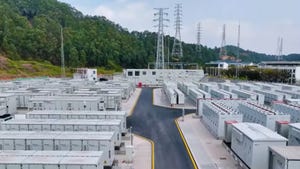Biden Supported EVs & Labor; Now They’re at Odds
Federal support for both EVs and organized labor has raised tensions in the UAW strike and put the White House in a tough spot.

The ongoing United Auto Workers (UAW) strike against the domestic automakers—Ford, GM, and Stellantis—is most publicly about wages and job security, but the transition from internal combustion engine (ICE) cars to battery-electric vehicles (BEVs) is an undenied underlying issue (as we’ve discussed).
As the strike verges on the one-week mark, the Biden administration has been blamed by the president’s political opponents and the US Chamber of Commerce for causing the strike, even while allies such as Rep. Debbie Dingell (D-MI) warn the administration not to intervene in the negotiations between the automakers and the UAW.
“The strike puts the administration and its supporters in a tricky spot,” Chris Douglas, professor of economics and chair of the department of social sciences and humanities at the University of Michigan-Flint, told Battery Technology.
“On one hand, they want to push the EV transition, but on the other hand, they want to support the UAW as organized labor is traditionally part of the Democratic base,” Douglas said. “I am sure the big policy push towards the shift to EVs has contributed to UAW-member anxiety about future employment in the auto industry, which is contributing to the inability of the UAW and auto companies to reach an agreement.”
In this tense environment, it’s worth looking more closely at how federal support for the goal of transitioning from ICE vehicles to BEVs seems to have contributed to bringing about this break between the domestic auto OEMs and the UAW.
National security concerns came first
Governmental support for electrification goals—in the form of legislation such as the Inflation Reduction Act (IRA) and infrastructure legislation—is rooted in very real national security concerns, pointed out Benny Daniel, vice president of consulting, mobility North America at Frost & Sullivan.
“The Federal Reserve’s role in the IRA program was primarily focused on enhancing material security, and consequently, national security, especially considering the significant competitive disparities—both in technology and cost—between the United States and China in the new energy sector,” Daniel told Battery Technology. “The main objective was to ensure the competitiveness of the electric vehicle (EV) industry, extending beyond just localization.”
However, the UAW leveraged this as a negotiating tool to secure higher-paying jobs, he said, which may inadvertently undermine that initial goal.
“Therefore, the shift towards EVs holds relatively less influence in driving strikes compared to other factors, such as a 40% increase in hourly wages, a reduced 32-hour workweek, the elimination of compensation tiers, a return to traditional pension plans, the restoration of cost-of-living adjustments, and improvements in vacation and family leave benefits, among other considerations,” Daniel noted. “That said, the political dynamics of the states where these strikes are occurring underscore the importance of government intervention to some extent, even though the [Biden administration’s] initial approach was rejected.”
Tough environmental goals—though technologically neutral
Wards Intelligence Analyst Adam Ragozzino makes the point that not only has the government been financially supportive of the domestic auto industry but also that “it’s also been technologically neutral for the most part.”
“However, the car makers had to choose a technology and run with it, and the choice was all-electric,” Ragozzino said. “The new, stricter emissions the EPA [Environmental Protection Agency] proposed in April could mean 67% of new vehicles sold in the US in 2032 would have to be electric—the industry is free to meet the proposal with any technology, but right now that’s electric.”
Those emissions goals are certainly adding to the pressure on the car companies—and the workforce, he noted. “The industry wasn’t even ready to commit to 50% in the US by that time. This transition wasn’t going to be easy, to begin with, and trying to do it faster will have some pain points. And the workers will likely be the first to feel some of that pain.”
What does the US driver want?
The other transition hiccup seems to be the consumer. The past year, in particular, has seen both the government and the car companies showing, with words and wallets, a full embrace of a battery-electric future. At the same time, many US drivers are still wary.
“The US consumer is, compared to other regions, slow to take up BEVs,” Ragozzino noted. He pointed out that the first to take up BEVs were innovators, followed by early adopters. “Both of those groups tend to be wealthier and willing to accept more risk with new products.” But now, he continued, with the US at around 7% BEV market penetration, “we are getting to the point where the market has to position the BEV for a mainstream consumer, and those consumers tend to be more pragmatic, more price-sensitive, and more risk-averse. So, a lot will have to change about BEVs to reach that market, especially price.”
If the industry can’t bring prices down fast enough, Ragozzino warned, consumers will choose something else over BEVs—another cause of industry tension.
“Wards Intelligence data shows an uptick in hybrid vehicles,” he noted. “Ford just announced it would increase hybrid production. So, it will be interesting to see if hybrids are what the mainstream consumer chooses. It would be ironic too, because Toyota execs have been saying all-electric may not be the only solution nor the fastest way to decarbonize cars. And they were vilified for it.”
The US government, the domestic automakers, and the UAW have all publicly accepted the goal of electrification (if somewhat grudgingly, in the case of the auto workers) in the past: Presumably, they eventually all will do so again once this standoff is resolved.
Meanwhile, as labor and management face off at the bargaining table, both seem to watch the administration—which contains key people, including the President, who were involved in bailing out two of the auto companies back in 2009, and which has been organized labor’s strongest governmental ally in almost half a century—with baleful eyes.
About the Author(s)
You May Also Like





